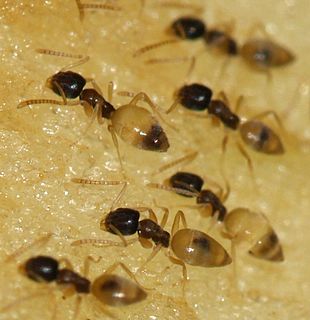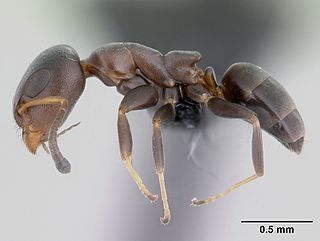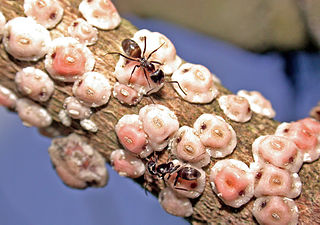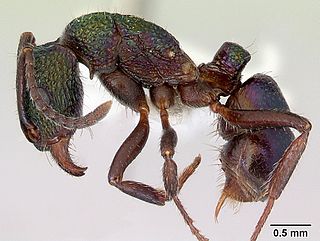
Dolichoderinae is a subfamily of ants, which includes species such as the Argentine ant, the erratic ant, the odorous house ant, and the cone ant. The subfamily presents a great diversity of species throughout the world, distributed in different biogeographic realms, from the Palearctic, Nearctic, Afrotropical region and Malaysia, to the Middle East, Australian, and Neotropical regions.

Tapinoma is a genus of ants that belongs to the subfamily Dolichoderinae. The genus currently comprises 74 described species distributed worldwide in tropical and temperate regions. Members of are generalized foragers, nesting in a wide variety of habitats, ranging from grasslands, open fields, woodlands, to inside buildings. The majority of species nest in the ground under objects such as stones or tree logs, other species build nests under bark of logs and stumps, in plant cavities, insect galls or refuse piles.

Turneria is a genus of ants that belongs to the subfamily Dolichoderinae. Known from Australia, they form small colonies of fewer than 500 workers, and nest in trees and twigs.

Dorymyrmex is a genus of ants in the subfamily Dolichoderinae.

Aphaenogaster is a genus of myrmicine ants. About 200 species have been described, including 18 fossil species. They occur worldwide except in South America south of Colombia, Sub-Saharan Africa, and Antarctica.

Crematogaster is an ecologically diverse genus of ants found worldwide, which are characterised by a distinctive heart-shaped gaster (abdomen), which gives them one of their common names, the Saint Valentine ant. Members of this genus are also known as cocktail ants because of their habit of raising their abdomens when alarmed. Most species are arboreal. These ants are sometimes known as acrobat ants.

Plagiolepis is an ant genus of the formic acid-producing subfamily Formicinae. The genus is found in tropical and temperate regions of the Old World.

Tetramorium is a genus of ants in the subfamily Myrmicinae that includes more than 520 species.

Aenictus is a large army ant genus distributed in the Old World tropics and subtropics. It contains about 181 species, making it one of the larger ant genera of the world.

Myrmecina is a genus of ants in the subfamily Myrmicinae. It contains 51 species distributed in North America, Europe, northern Africa, India east, Korea, Japan and Australia.

Rhytidoponera is a large genus of ants in the subfamily Ectatomminae. The genus is known from Australia and Melanesia, with New Caledonia as the most eastern limit.

Dolichoderus is a genus of ants found worldwide.

Sphinctomyrmex is a genus of ants in the subfamily Dorylinae. The genus is a pantropical and distinctive group, originally described by Mayr based on a single gyne collected in Brazil. Morphologically, the genus is characterized by the unique arrangement of the gastric segments, which are nearly equal in length and separated from each other by distinct constrictions. Very little is known on the natural history of Sphinctomyrmex. The few observations so far suggest that ants of this genus are nomadic predators of other ants.

Podomyrma is a genus of ants in the subfamily Myrmicinae.

Notoncus is an Australian genus of ants in the subfamily Formicinae. The genus is known from Australia, where the ants nest in the soil or on the ground under stones and logs in forested areas. The ants are also common in gardens and parks.
Chronoxenus butteli is an Indonesian ant of the genus Chronoxenus. It was once considered to be a part of the genus Iridomyrmex, and was moved from there to Chronoxenus. It was described by Forel in 1913.
Chronoxenus walshi is a species of ant of the genus Chronoxenus. It was described by Forel in 1895, and was formerly a part of the genus Iridomyrmex. They are endemic to Bangladesh, India and China.
Chronoxenus dalyi is a species of ant of the genus Chronoxenus. It was described by Forel in 1895. The ant is endemic to Bangladesh, India, Nepal and China.

Trichomyrmex is a genus of ants in the subfamily Myrmicinae. Described by Mayr in 1865, it was raised as a genus in 2015. These ants are endemic to multiple continents.
















